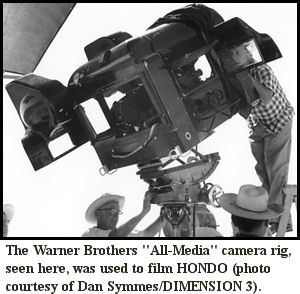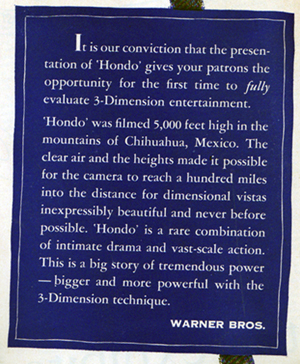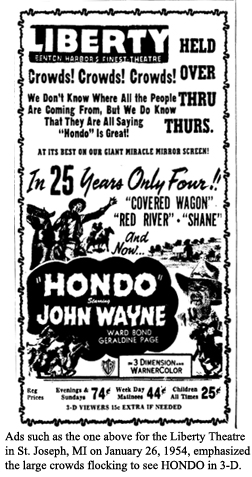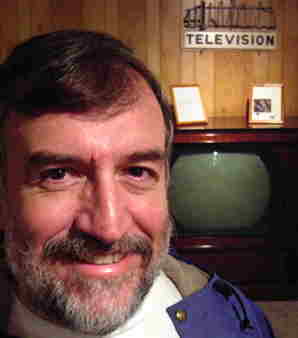The following article will present these facts documented with interactive sources.
The entire article is reprinted with permission from:
Birth of a Myth: the restoration of HONDO – 3DFPF – 3-D Film Preservation Fund a tax exempt 501(c)3 non profit corporatione following article is an interactive article. Sources are not cited with footnotes, but presented as hyperlinks. Each source will open as a JPG image when clicked on. Exact date and periodical is listed in the title of the image (eg. MOTIONPICTUREEXHIBITOR_071454.jpg is from The Motion Picture Exhibitor, July 14, 1954).
Production Background
Searching for an alternative to draw audiences away from television in the early 1950s, studios and exhibitors alike put their efforts into realism and new cinematic techniques. In November of 1952, stereoscopic movies made a big splash at the box office. Arch Oboler’s African adventure BWANA DEVIL, despite being considered a mediocre film, opened to great acclaim and capacity crowds. The public’s interest was not with the content of the film, but what was going on in the theater: lions were leaping into the audience, and there was an added dimension to the screen– depth. Despite decades of experiments, short subjects and failed attempts at 3-D, BWANA DEVIL had finally brought to the public an economic system of depth-realism. Oboler’s production gained its notoriety from its use of the Natural Vision three-dimensional camera. Natural Vision operated with two cameras, focused at angles and distances approximating two human eyes, and photographed the subject with two separate 35mm negatives. In projection, Polaroid filters were placed in front of two projectors running in precise synchronization and the left/right 35mm prints were projected onto a silver screen. Audience members wearing the special Polaroid glasses would then maintain an illusion of stereoscopic imagery in their sight.
Word spread around town instantly of Oboler’s financial success, and all of the major studios quickly went into production with their own 3-D films, either using the Natural Vision camera rig or devising their own. The most successful of these films was Warner’s HOUSE OF WAX (April 1953), starring Vincent Price and also released in the WarnerPhonic stereophonic sound system. Jack Warner, so impressed by the financial success of the film, announced a rigorous schedule of 22 films in 3-D, representing half of the studios upcoming shooting schedule.
 On May 19, Jack Warner announced the new All-Media Camera, a camera designed to shoot in any format– black and white or color, 3-D and/or widescreen, or flat. The rig was designed and built by the studios camera department, and would be utilized for the first time on HONDO. Cinematographers Robert Burks and Archie Stout would be shooting on location, in 3-D and widescreen. Films shot with the All-Media rig were composed for the aspect ratio of 1.75:1 or 1.85:1.
On May 19, Jack Warner announced the new All-Media Camera, a camera designed to shoot in any format– black and white or color, 3-D and/or widescreen, or flat. The rig was designed and built by the studios camera department, and would be utilized for the first time on HONDO. Cinematographers Robert Burks and Archie Stout would be shooting on location, in 3-D and widescreen. Films shot with the All-Media rig were composed for the aspect ratio of 1.75:1 or 1.85:1.
Principal photography began in Camargo, Mexico on June 11. The picturesque landscape would provide the perfect visual setting, but the director and cinematographers had trouble adjusting to the new camera. On June 18, Jack Warner viewed three reels of dailies and was concerned about the lack of close-ups, especially in the scene where John Wayne first meets Geraldine Page. He sent a telegram to the Duke and said “Director is not moving you and Geraldine close enough to camera. Everything seems to be too far away. Must have usual over-shoulder close shots individuals and tight twos in three-dimensional pictures so we can see peoples expressions and everything else.” On June 20, John Wayne replied: “Farrow has done everything but play music to get camera in for close shots. Seems our lenses are matted for 1.75 or 1.8 screen, plus fact that cameraman is over cautious for fear front office will scream eyestrain. Will show cameraman your wire. Think it will do the trick. He is really working hard but has limited us in making shots because of his fear and reluctance to do a shot that might throw background lines too wide an angle.”
Jack Warner’s advice was taken, and Robert Burks starting moving the camera in tighter for close shots. However, over the next several weeks, the elements proved to be a major problem. The intense heat, dust, wind and rain caused multiple delays throughout shooting. As a result, there are several shots in HONDO that are flat, due to a malfunction with one of the cameras.
By the end of the summer of 1953, interest began to dwindle in 3-D, resulting in a quick decline of both productions and exhibitions. Projectionists were finding it difficult to maintain synchronization between the two reels of film running during projection, a malfunction that would cause severe eye-strain and headaches for the audience. On September 16, 1953, 20th Century Fox premiered their anamorphic process CinemaScope with their production of THE ROBE. They wasted no time in advertising the new process as “the modern miracle you see without glasses.”
At the same time, several studios reversed their policy which had mandated that all 3-D movies must play their entire run of stereoscopic playdates before being available as a standard, flat film. With the studios’ new attitude towards the exhibition format, most exhibitors opted to play the new 3-D releases flat. By November 1953, 3-D was considered poison at the box office.
But 3-D movies weren’t dead yet. Due to newly developed technical advancements in projection techniques, the studios began a new campaign to bring back 3-D, with their ace being a new group of quality, high-budget 3-D films that would outshine the competition. Among the Fall/Winter 1953 season’s titles were Columbia’s MISS SADIE THOMPSON with Rita Hayworth, Paramount’s MONEY FROM HOME with Dean Martin and Jerry Lewis as well as Hal Wallis’ timely Korean War docu-drama CEASE FIRE, RKO’s scandalous production of THE FRENCH LINE with Jane Russell, MGM’s film version of the Cole Porter musical, KISS ME KATE and Warner Bros.’ highly anticipated John Wayne western HONDO.
Metro Goldwyn Mayer decided to test public opinion: they would exhibit KISS ME KATE in six theaters. Three theaters would play the film flat, and the remaining three would show it in 3-D. The public’s reaction would dictate which version would go into wide release. The 3-D showings had a substantially better response and KISS ME KATE went into wide release in either format, but with the suggestion that showmen across the country play the stereoscopic version of its film. With the exception of Radio City Music Hall, most other engagements for KATE were in 3-D.
 It was into this uncertain climate which HONDO first went into release. Jack Warner and his studio had been a staunch advocate of 3-D, and wasted no time in promoting their forthcoming release. The first trade ads appeared on November 7, and the film was trade-screened for the press on November 16, 1953. The reaction was sensational. Critics unanimously praised the film, and its effective use of stereoscopic cinematography. Warner Bros. was so enthusiastic about the films dimensional qualities, they made sure to emphasize that fact in their trade ads. In order to satisfy theaters not equipped for 3-D, Warner Bros. stated that HONDO would also be available in its flat version. With the official release date set for January, the studio assigned release #312 to the 3-D version, and #349 to the 2-D version.
It was into this uncertain climate which HONDO first went into release. Jack Warner and his studio had been a staunch advocate of 3-D, and wasted no time in promoting their forthcoming release. The first trade ads appeared on November 7, and the film was trade-screened for the press on November 16, 1953. The reaction was sensational. Critics unanimously praised the film, and its effective use of stereoscopic cinematography. Warner Bros. was so enthusiastic about the films dimensional qualities, they made sure to emphasize that fact in their trade ads. In order to satisfy theaters not equipped for 3-D, Warner Bros. stated that HONDO would also be available in its flat version. With the official release date set for January, the studio assigned release #312 to the 3-D version, and #349 to the 2-D version.
In an effort to ensure the highest quality presentations, the Polaroid Corporation (who obviously had a vested interest in the continued success of 3-D movies) developed and advertised new, comfortable plastic glasses and clip-ons as well as synchronization aids which would enable operators to quickly detect and remedy any out-of-sync 3-D presentation. Offered to theaters at a nominal cost, Polaroid did all they could to insure that the 3-D movie industry would last. They even took out special ads in local newspapers assuring the public that the 3-D to be seen in HONDO was better than anything they had seen before.
HONDO had its world premiere on November 24, 1953. John Wayne and Ward Bond flew to Texas for the premiere in Houston, and then went to a second premiere on November 25 in El Paso. Warner Bros. announced a special group of pre-release playdates commencing on Thanksgiving Day, November 26, 1953, in thirty-five major cities, including Detroit, Atlanta, Boston, and Washington. Any fear that 3-D would hurt the films box office potential was quickly diminished as HONDO did terrific business wherever it played, and was held-over for a second (and even for a third or fourth week) in most engagements. Jack Warner even placed an ad in both the Hollywood Reporter and Daily Variety boasting to his peers (and critics) about HONDO’s phenomenal success.
The studios publicity department went to work and sent View-Master preview reels to camera shops and movie theaters across the country. The View-Master reel depicted seven scenes from the film, each in full color and stereoscopic 3-D. National Screen service provided the cabinets in which the reel could be viewed, complete with a silk-screened, die-cut card on top of the cabinet. As part of their rigorous ad campaign, Warners arranged for a television contest to be broadcast on the CBS program, “The Big Payoff.”
Despite a city-wide newspaper strike wherein there was no advertising available, HONDO still managed to perform an amazing $55,000 during its first week engagement at the 3,664-seat Paramount Theater in New York. The film was held over for three weeks during this play date, and at the Paramount alone grossed $128,000 in ticket sales. A smash hit on his hands, Jack Warner was quick to re-state his faith in the future of 3-D movies.
 HONDO continued to pick up box office steam throughout December, where it opened in such major cities as St. Louis, Los Angeles, Cincinnati, Portland and Minneapolis. In January, 1954, it opened in additional cities, including San Francisco, Chicago, Oakland, Denver, Seattle and Toronto.
HONDO continued to pick up box office steam throughout December, where it opened in such major cities as St. Louis, Los Angeles, Cincinnati, Portland and Minneapolis. In January, 1954, it opened in additional cities, including San Francisco, Chicago, Oakland, Denver, Seattle and Toronto.
3-D bookings maintained their popularity into February. In New York alone, it opened on February 3, 1954 at 31 theaters in Manhattan, the Bronx and Westchester. One week later, ten additional RKO-circuit houses in Brooklyn and Queens added stereoscopic showings. This pattern of second-run and small-town dimensional bookings was typical of the widespread interest and success of HONDO. Even many drive-ins, which because of technical reasons were not usually 3-D friendly, played the stereoscopic version of the film.
Despite Warner’s announcement that any exhibitor had the option to play the film flat, it is interesting to note that until February 1954, all known bookings of HONDO were stereoscopic in every engagement. In fact, finding any flat bookings during this period proved difficult. One flat playdate was found at the sub-run booking of the 800-seat Belmont Theatre in Long Beach, CA, but only after having played two-weeks starting Christmas Day at the 1,800-seat State Theatre and the 1,200-seat Towne Theatre, both in 3-D.
March and April of 1954 found HONDO finally beginning to open at some small theaters and drive-ins which did not have the necessary equipment for stereoscopic exhibition, long after the 3-D version had played out its first-run engagements in that particular area. Even so, bookings in 3-D could still be found in such towns as Charleston, West Virginia and Winnipeg, Manitoba.
HONDO’s 3-D success was not limited to the U.S. On February 27, 1954, it opened to capacity crowds at London’s 1,734-seat Warner Theater, where it would play for five weeks and bring in over $40,000. Nearly three months later, HONDO was still playing in 3-D in theaters throughout South London.
With an average price of 49-cents a ticket in 1954, HONDO finished up the year with an impressive domestic gross of $4,100,000, a very large percentage of those being stereoscopic playdates. In 1954, HONDO was the 16th highest grossing film of the year, and the 106th top grossing film of all time. After Warner’s HOUSE OF WAX, which grossed an astonishing $6,500,000, it was the second highest grossing 3-D film of the 1950’s.
Restoration and Myth
In 1988, the late Michael Wayne, eldest son of John Wayne and head of Batjac Productions, took the film to Daniel Symmes. Both 3-D expert and historian, Mr. Symmes utilized the original left/right negatives to create a new 3-D version of HONDO for television (details about the history of the Wayne/Symmes restorations may be found in this informative article by Mr. Symmes himself). For technical reasons, instead of being presented in the polarized format, HONDO was converted to an anaglyph– the “red and blue” 3-D which many remembered from 3-D comic books in the 1950’s.
To promote the television premiere, Michael Wayne was interviewed in a June, 1991 Associated Press article. “When we started filming ‘Hondo’, 3-D was the rage. However, it takes a year to complete a film, and by that time, interest in 3-D had died down. So the film was only shown in 3-D in two theaters in the country for about a week. Fortunately, the film caught on without the 3-D and paid its negative cost in about eight weeks.” With all due respect to Mr. Wayne, he overlooked the fact that HONDO played across the country in 3-D. To be fair, he was 16 years old when it was released, and probably paid very little attention to the distribution pattern for his father’s new film.
The June, 1991 broadcast did substantially well in ratings, and collected a good amount of money for charity through the sale of glasses. But a video restoration was not enough for the determined Mr. Wayne; he wanted to insure that his father’s film-making legacy would survive for future generations. Commencing in April of 1994, Wayne and Symmes began an exhaustive on-film restoration of HONDO in hopes that someday it would be re-issued into theaters. The extensive restoration took several months and pooled various film materials and sources to create new 35mm preservation elements. The restored dual-strip 35mm 3-D print was excellent, and a great accomplishment by the team that had worked so hard to preserve the film. Unfortunately, the print was put into a storage vault and was never shown again.
When Michael Wayne passed away in 2003, his widow, Gretchen Wayne took over as head of Batjac Productions. In 2007, she announced that HONDO would be restored in a new digital 3-D version by Post Logic Studios, a company whose only previous experience in 3-D was the Robert Rodriguez film SPY KIDS 3-D. Unfortunately, between Mrs. Wayne and Post Logic Studios, more incorrect information was circulated about the film.
Noted magazines, papers and journals across the country continued to reprint the mistakes. In Variety, on May 9th, 2007, David S. Cohen’s article on Mrs. Wayne’s reissue screening at the Cannes film festival was riddled with errors. “Few people alive have seen it as it was meant to be seen,” wrote Cohen, who also added, “’Hondo’ in 3-D screened at only a few theaters and has almost never been seen in 3-D since.” In the same article, Gretchen Wayne is quoted: “I never really got it, it never really affected me that much…she says of the original 3-D, with its red-green anaglyph glasses.” Mr. Cohen not only made the same mistakes as Michael Wayne, he added his own. The only time HONDO was ever shown with anaglyphic (red and cyan, not red and green) glasses was the television broadcast of 1991.
Further confusion erupted in an article posted on digitalcontentproducer.com on May 15 by a Mr. “kraz.” “Post Logic received the original right eye and left eye film negative, which was shot in stereoscopic anaglyph for 3D viewing,” the article erroneously said. “Since the film was shot as an anaglyph, the left and right eye plates had to be as stable as possible, with little or no shifting between them,” one technician was quoted as saying. Aside from the fact that it is next to impossible to “shoot” an anaglyph in-camera, Post-Logic forgot all about the experts at Polaroid who had worked so hard fifty-four years earlier to insure that each theater presented HONDO in the absolute finest Polaroid projection.
Unfortunately, much of this 3-D history is forgotten today. Major industry papers such as Variety, The Hollywood Reporter, the New York Times and the Los Angeles Times frequently reprint the now-commonplace myth that 3-D films from the ’50s were seen with “red and green” glasses. The fact is that all 50 feature films from the “Golden Age” of 3-D (including “House of Wax”, “Creature From the Black Lagoon”, “Kiss Me Kate”, “It Came From Outer Space” and even “Robot Monster”) were shown with two projectors in Polaroid projection; none were shown in the anaglyphic format during their original release.
An article in 3-D Review Online Magazine on June 7 confused the facts even more. “In fact, this will be the first time ever that Hondo will be screened in 3-D in Europe” the report said, completely overlooking the successful London playdates. “Hondo was initially released in 3-D and played for a week in select major cities. However, Warner Bros. pulled the 3-D prints and general release prints were made in regular flat aspect ratio. Theater owners also found the projection process cumbersome, and the extra expense did not add appreciably to the box-office gross, so they preferred to show regular film prints.”
Further misinformation was printed that substantiated this quote in Michael Goldman’s article in Millimeter Magazine. “It was one of very few stereoscopic 3D screenings of Hondo that the world had ever seen because Jack Warner, then president of Warner Bros. Studios, had become convinced that the 3D craze was over by the time the movie was ready to be released. Warner decided it was too expensive to release the movie wide in the stereoscopic format. Hondo was exhibited as a traditional 2D film that year, built out of the original left-eye negative, and in the decades since, it has been seen in various home-video and broadcast versions as a standard 2D movie.” The same article repeated the misinformation about anaglyph glasses.
In conclusion, Mrs. Wayne was quoted as saying, “They were doing 3D [in the 1950s] to get people back into theaters, today, we have digital cinema, and about 700 or 800 theaters in the U.S. that can now show this movie in the format they wanted it shown in. And look what Jim Cameron and others are doing that’s all coming forward as a response to home entertainment systems. That’s why I think a Hondo tour would be a huge hit. Everyone knows John Wayne, but very few people have ever seen him in the 3D format.”
We respectfully disagree. As our research has proven, John Wayne was seen in magnificent Polaroid 3-D by several million people, to say the least.
 Special thanks to Dan Symmes, Jeff Joseph, Leith Adams (Warner Bros. Archive), Sandra J. Lee and Ned Comstock (USC Cinematic Arts Library, USC Warner Bros. Archives), Newspaperarchive.com, Greg Kintz and the New York Public Library. This article and its contents © Copyright 2007, The 3-D Film Preservation Fund/Bob Furmanek/Jack Theakston
Special thanks to Dan Symmes, Jeff Joseph, Leith Adams (Warner Bros. Archive), Sandra J. Lee and Ned Comstock (USC Cinematic Arts Library, USC Warner Bros. Archives), Newspaperarchive.com, Greg Kintz and the New York Public Library. This article and its contents © Copyright 2007, The 3-D Film Preservation Fund/Bob Furmanek/Jack Theakston


 On May 19, Jack Warner announced the new
On May 19, Jack Warner announced the new It was into this uncertain climate which HONDO first went into release. Jack Warner and his studio had been a staunch advocate of 3-D, and wasted no time in promoting their forthcoming release. The first trade ads appeared on
It was into this uncertain climate which HONDO first went into release. Jack Warner and his studio had been a staunch advocate of 3-D, and wasted no time in promoting their forthcoming release. The first trade ads appeared on HONDO continued to pick up box office steam throughout
HONDO continued to pick up box office steam throughout Special thanks to Dan Symmes, Jeff Joseph, Leith Adams (Warner Bros. Archive), Sandra J. Lee and Ned Comstock (USC Cinematic Arts Library, USC Warner Bros. Archives), Newspaperarchive.com, Greg Kintz and the New York Public Library. This article and its contents © Copyright 2007, The 3-D Film Preservation Fund/Bob Furmanek/Jack Theakston
Special thanks to Dan Symmes, Jeff Joseph, Leith Adams (Warner Bros. Archive), Sandra J. Lee and Ned Comstock (USC Cinematic Arts Library, USC Warner Bros. Archives), Newspaperarchive.com, Greg Kintz and the New York Public Library. This article and its contents © Copyright 2007, The 3-D Film Preservation Fund/Bob Furmanek/Jack Theakston

